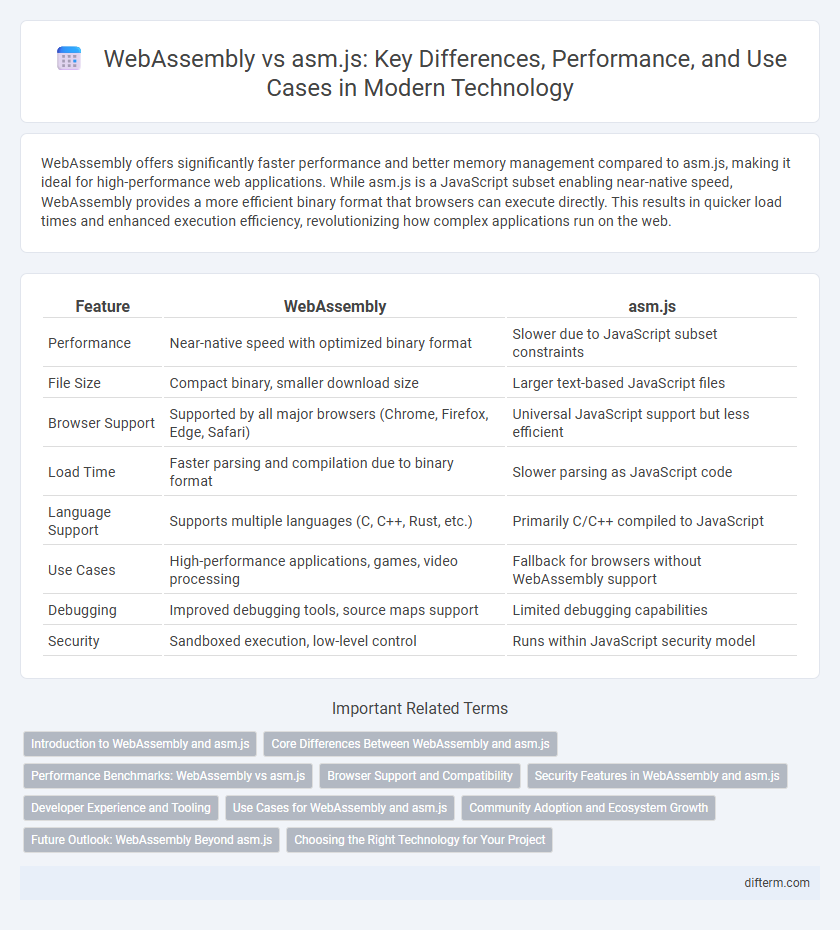WebAssembly offers significantly faster performance and better memory management compared to asm.js, making it ideal for high-performance web applications. While asm.js is a JavaScript subset enabling near-native speed, WebAssembly provides a more efficient binary format that browsers can execute directly. This results in quicker load times and enhanced execution efficiency, revolutionizing how complex applications run on the web.
Table of Comparison
| Feature | WebAssembly | asm.js |
|---|---|---|
| Performance | Near-native speed with optimized binary format | Slower due to JavaScript subset constraints |
| File Size | Compact binary, smaller download size | Larger text-based JavaScript files |
| Browser Support | Supported by all major browsers (Chrome, Firefox, Edge, Safari) | Universal JavaScript support but less efficient |
| Load Time | Faster parsing and compilation due to binary format | Slower parsing as JavaScript code |
| Language Support | Supports multiple languages (C, C++, Rust, etc.) | Primarily C/C++ compiled to JavaScript |
| Use Cases | High-performance applications, games, video processing | Fallback for browsers without WebAssembly support |
| Debugging | Improved debugging tools, source maps support | Limited debugging capabilities |
| Security | Sandboxed execution, low-level control | Runs within JavaScript security model |
Introduction to WebAssembly and asm.js
WebAssembly is a low-level binary instruction format designed to enable high-performance applications on web platforms, providing faster execution and efficient memory usage compared to asm.js, a JavaScript subset that serves as a fallback for older browsers. Unlike asm.js, which relies on JavaScript engines to parse and execute code, WebAssembly offers near-native speed by running in a compact binary format that modern browsers can decode quickly. WebAssembly supports multiple programming languages, making it a versatile solution for web developers seeking improved performance and broad compatibility.
Core Differences Between WebAssembly and asm.js
WebAssembly provides a binary instruction format designed for faster parsing and near-native execution speeds compared to asm.js, which is a subset of JavaScript optimized for performance. WebAssembly supports a wider range of languages through direct compilation, enabling more efficient memory management and multi-threading capabilities that asm.js lacks. Furthermore, WebAssembly's compact size and streamlined decoding process result in lower latency and improved performance in web applications relative to asm.js.
Performance Benchmarks: WebAssembly vs asm.js
WebAssembly consistently outperforms asm.js in performance benchmarks, delivering near-native execution speeds due to its binary format and efficient runtime optimizations. WebAssembly's compact size reduces load times and improves parsing efficiency compared to asm.js's verbose JavaScript code. Performance tests, such as those conducted with the WebAssembly Benchmark Suite, demonstrate WebAssembly's superiority in CPU-intensive tasks and real-time applications, highlighting its advantage for high-performance web computing.
Browser Support and Compatibility
WebAssembly offers near-universal browser support across Chrome, Firefox, Safari, and Edge, ensuring high compatibility for modern web applications, whereas asm.js relies on JavaScript engines and has broader support in older browsers. WebAssembly's binary format delivers improved performance and faster loading times compared to asm.js's textual subset of JavaScript, making it more efficient in browser execution. Developers benefit from WebAssembly's consistent API and enhanced debugging tools, which streamline cross-browser compatibility and improve web application reliability.
Security Features in WebAssembly and asm.js
WebAssembly offers enhanced security features compared to asm.js by incorporating sandboxed execution environments that prevent direct access to the host system, reducing the risk of buffer overflow and memory corruption vulnerabilities. It uses a structured, bytecode format with strict validation and predictable behavior which makes exploitation significantly harder than asm.js's JavaScript-based code. WebAssembly's strong typing and control-flow integrity contribute to mitigating common security issues prevalent in asm.js, ensuring safer execution of web applications.
Developer Experience and Tooling
WebAssembly offers a significantly improved developer experience compared to asm.js by providing near-native performance and a compact binary format that reduces load times. Modern tooling ecosystems, including debuggers, profilers, and integration with existing JavaScript frameworks, enhance productivity and ease troubleshooting. WebAssembly's standardized support across major browsers and compatibility with multiple languages streamlines development workflows and broadens application possibilities.
Use Cases for WebAssembly and asm.js
WebAssembly enables high-performance web applications such as gaming, virtual reality, and CAD software by providing near-native execution speeds and efficient memory usage, outperforming asm.js in computationally intensive tasks. asm.js serves as a fallback solution compatible with older browsers, supporting web applications that require predictable JavaScript performance without browser-level WebAssembly support. WebAssembly's integration with modern web APIs and support for multiple languages broadens its use cases beyond asm.js, facilitating complex applications like video editing and scientific simulations directly in the browser.
Community Adoption and Ecosystem Growth
WebAssembly has gained significant community adoption due to its superior performance and broader support across modern browsers, outperforming asm.js in execution speed and efficiency. The ecosystem around WebAssembly continues to expand rapidly, with extensive tooling, libraries, and frameworks emerging, while asm.js support has plateaued as developers shift focus. Major industry players and open-source contributors actively invest in WebAssembly, enhancing its integration with existing web technologies and driving robust ecosystem growth.
Future Outlook: WebAssembly Beyond asm.js
WebAssembly offers a significant upgrade over asm.js by providing faster execution speeds and better performance optimization through its binary format, making it ideal for complex web applications and games. Its growing ecosystem supports multiple languages such as Rust, C++, and Go, enhancing cross-platform compatibility and developer productivity. With continued browser support and expanding use cases in edge computing and IoT, WebAssembly is poised to redefine web application development beyond the constraints of asm.js.
Choosing the Right Technology for Your Project
WebAssembly offers faster execution and more efficient binary format compared to asm.js, making it ideal for performance-critical web applications such as gaming and complex simulations. asm.js provides broader compatibility with older browsers and is easier to debug during development, suitable for projects prioritizing immediate browser support. Evaluating your project's performance requirements, browser compatibility goals, and development timeline will help determine whether WebAssembly or asm.js aligns best with your technical needs.
WebAssembly vs asm.js Infographic

 difterm.com
difterm.com